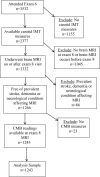Carotid Atherosclerosis and Cerebral Microbleeds: The Framingham Heart Study
- PMID: 26994127
- PMCID: PMC4943235
- DOI: 10.1161/JAHA.115.002377
Carotid Atherosclerosis and Cerebral Microbleeds: The Framingham Heart Study
Abstract
Background: Carotid atherosclerosis is associated with subclinical ischemic cerebrovascular disease, but its role in hemorrhage-prone small vessel disease-represented by cerebral microbleed (CMB)-is unclear, although vascular risk factors underlie both conditions. We hypothesized that persons with carotid atherosclerosis would have higher risk of CMB, particularly in deep regions.
Methods and results: We studied 1243 participants in the Framingham Offspring Study (aged 56.9±8.8 years; 53% women) with carotid ultrasound available on 2 occasions (1995-1998 and 2005-2008) prior to brain magnetic resonance imaging. Using multivariable logistic regression, we related baseline carotid stenosis, baseline intima-media thickness, and site-specific carotid intima-media thickness progression (at internal and common carotid locations) to the prevalence and location (lobar or deep plus mixed) of CMB. In addition, we assessed effect modification by lipid levels and use of statin and antithrombotic medications. Carotid stenosis ≥25% (a marker of cerebrovascular atherosclerosis) was associated with presence of CMB overall (Odds Ratio 2.20, 95% CI 1.10-4.40) and at deep and mixed locations (odds ratio 3.60, 95% CI 1.23-10.5). Baseline carotid intima-media thickness was not associated with CMB. Progression of common carotid artery intima-media thickness among persons on hypertension treatment was associated with lower risk of deep and mixed CMB (odds ratio per SD 0.41, 95% CI 0.18-0.96).
Conclusions: Cumulative vascular risk factor exposure may increase the risk of CMB, especially in deep regions. The apparent paradoxical association of carotid intima-media thickness progression with lower risk of CMB may reflect benefits of intensive vascular risk factor treatment among persons with higher cardiovascular risk and deserves further investigation. If replicated, the results may have potential implications for assessment of preventive and therapeutic interventions for subclinical cerebral hemorrhage.
Keywords: brain magnetic resonance imaging; carotid atherosclerosis; carotid intima–media thickness; cerebral microbleeds.
© 2016 The Authors. Published on behalf of the American Heart Association, Inc., by Wiley Blackwell.
Figures
References
-
- O'Leary DH, Polak JF, Kronmal RA, Manolio TA, Burke GL, Wolfson SK Jr. Carotid‐artery intima and media thickness as a risk factor for myocardial infarction and stroke in older adults. Cardiovascular Health Study Collaborative Research Group. N Engl J Med. 1999;340:14–22. - PubMed
-
- Mathiesen EB, Waterloo K, Joakimsen O, Bakke SJ, Jacobsen EA, Bonaa KH. Reduced neuropsychological test performance in asymptomatic carotid stenosis: the Tromso Study. Neurology. 2004;62:695–701. - PubMed
-
- Peters SA, den Ruijter HM, Bots ML. Attenuation of rate of change in carotid intima‐media thickness by lipid‐modifying drugs: impact on clinical outcomes. Am J Cardiovasc Drugs. 2011;11:253–263. - PubMed
-
- Ozaki K, Kubo T, Imaki R, Shinagawa H, Fukaya H, Ohtaki K, Ozaki S, Izumi T, Aizawa Y. The anti‐atherosclerotic effects of lipid lowering with atorvastatin in patients with hypercholesterolemia. J Atheroscler Thromb. 2006;13:216–219. - PubMed
Publication types
MeSH terms
Substances
Grants and funding
- N01-HC-25195/HC/NHLBI NIH HHS/United States
- R01 NS017950/NS/NINDS NIH HHS/United States
- R01 AG054076/AG/NIA NIH HHS/United States
- R01AG16495/AG/NIA NIH HHS/United States
- 1 R01 AG028321/AG/NIA NIH HHS/United States
- R01 NS17950/NS/NINDS NIH HHS/United States
- 2K24HL04334/HL/NHLBI NIH HHS/United States
- AG08122/AG/NIA NIH HHS/United States
- HHSN268201500001I/PHS HHS/United States
- K23AG038444/AG/NIA NIH HHS/United States
- K23 AG038444/AG/NIA NIH HHS/United States
- P30 AG010129/AG/NIA NIH HHS/United States
- R03 AG048180/AG/NIA NIH HHS/United States
- HL67288/HL/NHLBI NIH HHS/United States
- R01 HL076784/HL/NHLBI NIH HHS/United States
- 1R01 HL64753/HL/NHLBI NIH HHS/United States
- 1R03 AG048180‐01A1/AG/NIA NIH HHS/United States
LinkOut - more resources
Full Text Sources
Other Literature Sources


